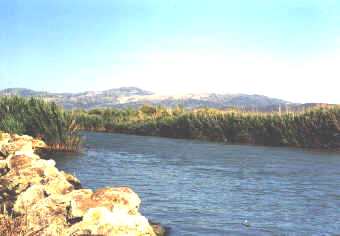
The Acheron, as it appears
today, near its mouth,
in the Ammoudia bay.
In those dramatic circumstances Ephyra's Nekromanteion was besieged and, judging from the findings, siege devices were used. The fire, set to the upper floor, fed by flammable materials contained on the inside, burnt the wooden-beam floor and debris covered the lower floor.
The oracle, supposing it survived as a cult place, lost any importance. About a century later, a Roman settlement occupied part of the area, as it is testified by some tiles recovered, bearing Latin letters. The Acherousian lake turned its name into "Aornos".
With time, even some geographic features of the area partly changed: the Ammoudia bay got narrower because of the detrital material deposited by the Acheron; the river itself partly changed its course; the wide sheet of swampy water at the foot of the hill of Ephyra's Nekromanteion, the Acherousian lake, progressively receded until disappearing completely, after the drainage operated in 1951 and is now replaced by a wide, blooming plain.

The Acheron, as it appears
today, near its mouth,
in the Ammoudia bay.